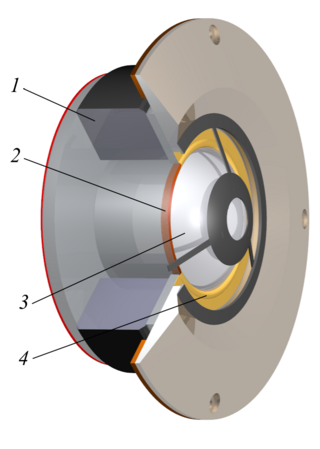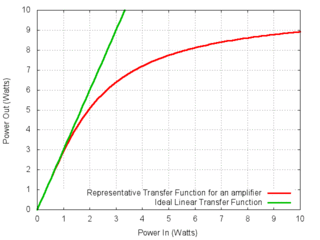Related Research Articles

A subwoofer is a loudspeaker designed to reproduce low-pitched audio frequencies known as bass and sub-bass, lower in frequency than those which can be (optimally) generated by a woofer. The typical frequency range for a subwoofer is about 20–200 Hz for consumer products, below 100 Hz for professional live sound, and below 80 Hz in THX-certified systems. Thus one or more subwoofers are important for high quality sound reproduction as they are responsible for the lowest two to three octaves of the ten that are audible. This very low-frequency (VLF) range reproduces the natural fundamental tones of the bass drum, electric bass, double bass viol, cello, grand piano, contra bassoon, tuba, and organ, in addition to thunder and explosions.

A loudspeaker is an electroacoustic transducer that converts an electrical audio signal into a corresponding sound. A speaker system, also often simply referred to as a "speaker" or "loudspeaker", comprises one or more such speaker drivers, an enclosure, and electrical connections possibly including a crossover network. The speaker driver can be viewed as a linear motor attached to a diaphragm which couples that motor's movement to motion of air, that is, sound. An audio signal, typically from a microphone, recording, or radio broadcast, is amplified electronically to a power level capable of driving that motor in order to reproduce the sound corresponding to the original unamplified electronic signal. This is thus the opposite function to the microphone; indeed the dynamic speaker driver, by far the most common type, is a linear motor in the same basic configuration as the dynamic microphone which uses such a motor in reverse, as a generator.

A tweeter or treble speaker is a special type of loudspeaker that is designed to produce high audio frequencies, typically deliver high frequencies up to 100 kHz. The name is derived from the high pitched sounds made by some birds (tweets), especially in contrast to the low woofs made by many dogs, after which low-frequency drivers are named (woofers).
A woofer or bass speaker is a technical term for a loudspeaker driver designed to produce low frequency sounds, typically from 50 Hz up to 1000 Hz. The name is from the onomatopoeic English word for a dog's bark, "woof". The most common design for a woofer is the electrodynamic driver, which typically uses a stiff paper cone, driven by a voice coil surrounded by a magnetic field.
Audio power is the electrical power transferred from an audio amplifier to a loudspeaker, measured in watts. The electrical power delivered to the loudspeaker, together with its efficiency, determines the sound power generated.

In an audio system, the damping factor gives the ratio of the rated impedance of the loudspeaker to the source impedance of the power amplifier. Only the magnitude of the loudspeaker impedance is used, and the power amplifier output impedance is assumed to be totally resistive.

A horn loudspeaker is a loudspeaker or loudspeaker element which uses an acoustic horn to increase the overall efficiency of the driving element(s). A common form (right) consists of a compression driver which produces sound waves with a small metal diaphragm vibrated by an electromagnet, attached to a horn, a flaring duct to conduct the sound waves to the open air. Another type is a woofer driver mounted in a loudspeaker enclosure which is divided by internal partitions to form a zigzag flaring duct which functions as a horn; this type is called a folded horn speaker. The horn serves to improve the coupling efficiency between the speaker driver and the air. The horn can be thought of as an "acoustic transformer" that provides impedance matching between the relatively dense diaphragm material and the less-dense air. The result is greater acoustic output power from a given driver.

JBL is an American audio equipment manufacturer headquartered in Los Angeles, California, United States. JBL serves the customer home and professional market. The professional market includes studios, installed/tour/portable sound, cars, music production, DJ, cinema markets, etc. JBL is owned by Harman International, an independent subsidiary of Samsung Electronics.

A voice coil is the coil of wire attached to the apex of a loudspeaker cone. It provides the motive force to the cone by the reaction of a magnetic field to the current passing through it.
Thiele/Small parameters are a set of electromechanical parameters that define the specified low frequency performance of a loudspeaker driver. These parameters are published in specification sheets by driver manufacturers so that designers have a guide in selecting off-the-shelf drivers for loudspeaker designs. Using these parameters, a loudspeaker designer may simulate the position, velocity and acceleration of the diaphragm, the input impedance and the sound output of a system comprising a loudspeaker and enclosure. Many of the parameters are strictly defined only at the resonant frequency, but the approach is generally applicable in the frequency range where the diaphragm motion is largely pistonic, i.e. when the entire cone moves in and out as a unit without cone breakup.

Magnepan is a private high-end audio loudspeaker manufacturer in White Bear Lake, Minnesota, United States. Their loudspeaker technology was conceived and implemented by engineer Jim Winey in 1969.

Powered speakers, also known as self-powered speakers and active speakers, are loudspeakers that have built-in amplifiers. Powered speakers are used in a range of settings, including in sound reinforcement systems, both for the main speakers facing the audience and the monitor speakers facing the performers; by DJs performing at dance events and raves; in private homes as part of hi-fi or home cinema audio systems and as computer speakers. They can be connected directly to a mixing console or other low-level audio signal source without the need for an external amplifier. Some active speakers designed for sound reinforcement system use have an onboard mixing console and microphone preamplifier, which enables microphones to be connected directly to the speaker.
The chief electrical characteristic of a dynamic loudspeaker's driver is its electrical impedance as a function of frequency. It can be visualized by plotting it as a graph, called the impedance curve.

Gain compression is a reduction in differential or slope gain caused by nonlinearity of the transfer function of the amplifying device. This nonlinearity may be caused by heat due to power dissipation or by overdriving the active device beyond its linear region. It is a large-signal phenomenon of circuits.

The moving iron speaker was the earliest type of electric loudspeaker. They are still used today in some miniature speakers where small size and low cost are more important than sound quality. A moving iron speaker consists of a ferrous-metal diaphragm or reed, a permanent magnet and a coil of insulated wire. The coil is wound around the permanent magnet to form a solenoid. When an audio signal is applied to the coil, the strength of the magnetic field varies, and the springy diaphragm or reed moves in response to the varying force on it. The moving iron loudspeaker Bell telephone receiver was of this form. Large units had a paper cone attached to a ferrous metal reed.

A compression driver is a small specialized diaphragm loudspeaker which generates the sound in a horn loudspeaker. It is attached to an acoustic horn, a widening duct which serves to radiate the sound efficiently into the air. It works in a "compression" mode; the area of the loudspeaker diaphragm is significantly larger than the throat aperture of the horn so that it provides high sound pressures. Horn-loaded compression drivers can achieve very high efficiencies, around 10 times the efficiency of direct-radiating cone loudspeakers. They are used as midrange and tweeter drivers in high power sound reinforcement loudspeakers, and in reflex or folded-horn loudspeakers in megaphones and public address systems.

An electrodynamic speaker driver, often called simply a speaker driver when the type is implicit, is an individual transducer that converts an electrical audio signal to sound waves. While the term is sometimes used interchangeably with the term speaker (loudspeaker), it is usually applied to specialized transducers which reproduce only a portion of the audible frequency range. For high fidelity reproduction of sound, multiple loudspeakers are often mounted in the same enclosure, each reproducing a different part of the audible frequency range. In this case the individual speakers are referred to as drivers and the entire unit is called a loudspeaker. Drivers made for reproducing high audio frequencies are called tweeters, those for middle frequencies are called mid-range drivers, and those for low frequencies are called woofers, while those for very low bass range are subwoofers. Less common types of drivers are supertweeters and rotary woofers.
The Wharfedale MACH series of loudspeakers consists of the MACH 3, 5, 7, and 9. This is an informational page devoted to owners and users of these loudspeakers and those interested in history and construction of electronic sound reproduction.

DUPLEX was the trade name given by Altec Lansing to its line of coaxial loudspeakers, beginning with the first model 601 in 1943. However, the name was most commonly associated with the subsequent model 604 which was a seminal loudspeaker that became a milestone in loudspeaker development. Well over a dozen different models carried the Duplex name over a near 50-year period. The vast majority consisted of a high frequency (HF) compression driver mounted to the back of a large diameter paper cone low frequency (LF) driver. However, there were also a few models with small diameter LF cones and direct radiator tweeters.
Thomas J. Danley is an American audio engineer, electrical engineer and inventor, the holder of multiple patents for audio transducers, especially high-linearity, high-output professional horn loudspeaker systems. Danley first gained notice in the 1980s with his novel servomotor-driven subwoofer systems used to reproduce very low frequencies in concert tours and theme parks. In 2000 he advanced the implementation of multiple-entry horns in 2000 with several designs led by the SPL-td1, a seven-driver loudspeaker. In 2005, he started a new company, Danley Sound Labs, through which he patented further technologies and produced a wide variety of loudspeaker models based on these technologies.
References
- ↑ JBL Staff (2004). "Frequently Asked Questions: What is power compression?". JBL Pro Audio. Retrieved August 14, 2019.
- ↑ Boyce, Teddy (2014). Introduction to Live Sound Reinforcement: The Science, the Art, and the Practice. FriesenPress. p. 78. ISBN 9781460238912.
- 1 2 3 4 Howard, Keith (November 26, 2006). "Hot Stuff: Loudspeaker Voice-Coil Temperatures". Stereophile. AVTech Media Americas. Retrieved August 14, 2019. Link to page 2.
- 1 2 Watkinson, John (May 28, 2018). "Loudspeaker Technology Part 16: Moving Coil Motors". The Broadcast Audio Bridge. International Techmedia. Retrieved August 14, 2019.
- ↑ Button, Douglas J. (1992). Heat Dissipation and Power Compression in Loudspeakers. JBL. Published by the Audio Engineering Society.
- ↑ Danley, Thomas J. (1986) "The Elimination of Power Compression in Servo Drive Loudspeakers," Presented at the 81st Convention of the AES.